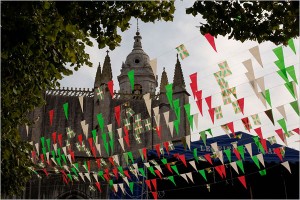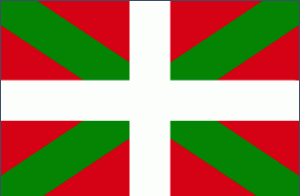“Have you ever seen one of those great steel balls that hang from a crane and that they use to knock down buildings? The crane lifts up the ball and lets it fall on the building. That’s exactly what’s happened in the Basque Country. Except that there the ball is out of control.”
In September,  1957, Joseba, the speaker who opens the novel, and his friend David Imaz are both eight years old when they introduce themselves to the new teacher at their Basque school in Obaba, near Guernica, Spain. David, sometimes called “the accordionist’s son,” is, like his father, an accordionist–an “artist” at his craft–and almost instantly, he finds himself perched on top of a desk, playing for his delighted class. Forty-two years later, the accordion is put away, and Joseba is visiting David’s widow, not in Basque country, but at Stoneham Ranch in Three Rivers, California, where David’s uncle once lived, and where David has been raising thoroughbred horses for more than twenty-five years. Joseba has been visiting there for a month, overseeing David’s epitaph, which is written in three languages–Basque, Spanish, and English—and coming to know his American wife Mary Ann, his two young daughters, Liz and Sara, and the completely different life that David chose for himself after he left Obaba when he was in his mid-twenties.
1957, Joseba, the speaker who opens the novel, and his friend David Imaz are both eight years old when they introduce themselves to the new teacher at their Basque school in Obaba, near Guernica, Spain. David, sometimes called “the accordionist’s son,” is, like his father, an accordionist–an “artist” at his craft–and almost instantly, he finds himself perched on top of a desk, playing for his delighted class. Forty-two years later, the accordion is put away, and Joseba is visiting David’s widow, not in Basque country, but at Stoneham Ranch in Three Rivers, California, where David’s uncle once lived, and where David has been raising thoroughbred horses for more than twenty-five years. Joseba has been visiting there for a month, overseeing David’s epitaph, which is written in three languages–Basque, Spanish, and English—and coming to know his American wife Mary Ann, his two young daughters, Liz and Sara, and the completely different life that David chose for himself after he left Obaba when he was in his mid-twenties.
Mary Ann has a mission for Joseba. She wants him to take one of the three copies of a book that David has written in Basque back to the library in Obaba. It is David’s life story, including his involvement in the history of his Basque village, and it reveals important discoveries he made about other people in the village, including some of his own family, who sided with the fascists during the Spanish Civil War (1936 – 39) and may have murdered some of their fellow citizens. It also contains other information about David’s life “before California,” a life that he has not shared with his wife and daughters but believes they have a right to know upon his death.

Joseba, a published author who also participated in the events in Obaba with David, discovers when he reads David’s book that “events and facts have all been crammed” into the book, “like anchovies in a glass jar.” He suggests to Mary Ann that he rewrite the book, expanding David’s memoir and setting the record straight, promising that “any lines I add…must be true to the original.” Mary Ann agrees, and three years later Joseba has completed the book which becomes the text of this novel.
As David’s story unfolds, the divisions within the town of Obaba and within the Imaz family are clear. Uncle Juan, his father’s brother, is close to David, and Juan does not hide the fact that he loathes Capt. Degrela, who recruited for the fascists during the war. Degrela now owns the local hotel, where he hangs out with David’s father Angel and the hotel manager, known locally as “Berlino” for his past sympathies. Nine local people, thought to have been sympathetic to the revolution and against the military dictatorship, were murdered at the outset of the war, and David believes that Capt. Degrela, “Berlino,” and his own father were involved in these atrocities.

Basque cathedral with pennants in colors of Basque flag
For reasons David does not initially understand, his beloved Uncle Juan does not live in town, where David’s family lives, preferring the country life at Iruain, outside Obaba, where he raises horses when he is not working in California. David, too, prefers the country life, and his firmest friendships occur during school vacations when he can spend time with the local boys from the country, not the better educated children who are schooled in town. It is through his travels back and forth between town and country, and through his relationships with both groups, however, that he eventually learns the true history of the town in the years before he was born. As he is investigating this history, however, he is also dealing with traditional (and, in his case, not-so-traditional) parent-child problems and the urgencies of adolescence.

Basque flag
By June, 1970, David, aged 22, has finished his fourth year of university, and the political situation in his Basque homeland, relatively peaceful for years, has seriously deteriorated. Gen. Franco and the military dictatorship fear that the Basque region is fomenting communist-style revolution, and they are watching activities there carefully. The bombing of a recently erected marble monument, created to honor the fascists who fought with Franco during the Civil War, combined with the burning of the Spanish flag and the raising of the Basque flag over the town hall brings the military to Obaba, at the same time that reform-minded college students from outside Obaba also arrive, setting up a final confrontation and bringing the novel full-circle.
Though the novel sounds like a “historical novel,” the Basque setting and the events of the Spanish Civil War, which drive the plot, seem less important to the author and the reader than the characters and the crises they face. Atxaga is intent upon creating a vibrant picture of life in a rural Basque community, and as he recreates the culture, introduces the kinds of people who live within it, and includes homey details in his descriptions, the reader sees how much like the rest of us these people are, despite their obvious cultural differences. In their childhood, David and Joseba and their friends act like typical young boys, enjoying the same kinds of activities that children enjoy around the world, and when, as teenagers and youths in their early twenties, they become caught up in events, the results of which they cannot possibly foresee, the reader understands that they are innocent of malice, just naïve youths caught in a whirlwind that has taken their lives out of control.

General Franco
Despite the lengthy cast of characters, the characters are realistic and honestly depicted, and most of them come alive for the reader. Raquel Welch riding a horse in a bikini, children playing with the skull of a dead horse, and a donkey crashing a party to distribute pamphlets listing the prettiest girls in Obaba, all add to the atmosphere and the sense of “rightness” of Atxaga’s story. Written by one of the few novelists still writing in the Basque language, The Accordionist’s Son is a novel of epic scope and broad social impact, a novel which grows for the reader because the author chooses to be honest about his characters, instead of molding them to the needs of his plot. (On my Favorites List for 2009.)
ALSO by Bernardo Atxaga: OBABAKOAK and SEVEN HOUSES IN FRANCE
Notes: The author’s photo by Gorka Salmeron is from his website: http://www.atxaga.org
This Basque cathedral with penants showing the colors of the Basque flag is from: http://www.nytimes.com
Basque flag from http://www.lavillabasque.com
The image of Gen. Franco is here: http://sitemaker.umich.edu
